Painting How To
Plums: Step-by-Step Painting Tutorial
Inspired by the sweetness of plums
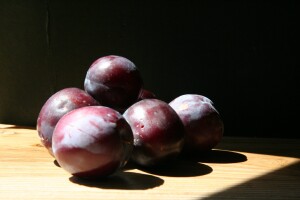
This painting tutorial begins on a beautiful summer afternoon when we picked these plums at our friend’s little farm. Returning home, at first sight, the plums on the kitchen counter look like the simple purple fruit we all know. But when they were placed in full sun, they glowed with warm colors, and shadow were drenched in rich, deep bluish purple. As a result, that beauty begged to be painted.
Materials
Canvas panel
(acrylic double primed)
Paints (M Graham)
In the order arranged on my palette
Anthraquinone Red
Alizarin Crimson
Cadmium Red
Cadmium Yellow Deep
Cadmium Yellow
Titanium White
Indian Yellow
Viridian
Ultramarine Blue
Transparent Red Iron Oxide
Ivory Blue
Varnish (for restoring color brilliance)
Blair Retouch Varnish
Medium
M Graham Walnut Alkyd Medium
Gamlin Aylkyd Gel Medium
Brushes
Rosemary and Co. Brushes
Evergreen Synthetic
Hogs hair bristle
Other Tools
4B Graphite Pencil
Kneaded Eraser
Metal ruler straight edge
Reducing Glass
Palette Knife (only for mixing)
Other Materials
Paper Towels
Turpenoid Natural
Master’s Brush Cleaner
STEP 1: The setup

Reference
Painting a still life of fruit or veggies often takes me several days to finish. I ‘m not interested in painting spoiled fruit. Also, the natural light I use is naturally shifty – it just doesn’t stay still, and it gets dark at night (go figure). Therefore, I often take photographs for reference. Of course, I do keep some real fruit on hand for true color reference.
Goal: Celebration of color
In this painting my goal is to amplify the plum colors and texture. I place a small, rugged vase with the plums to contrast with their smooth skins. The vase’s green tones helps punch up the impact of the plum’s purples and warm colors. The composition is a classic pyramid arrangement, strengthened by the shape of the cast shadow on the right.
STEP 2: Drawing on canvas
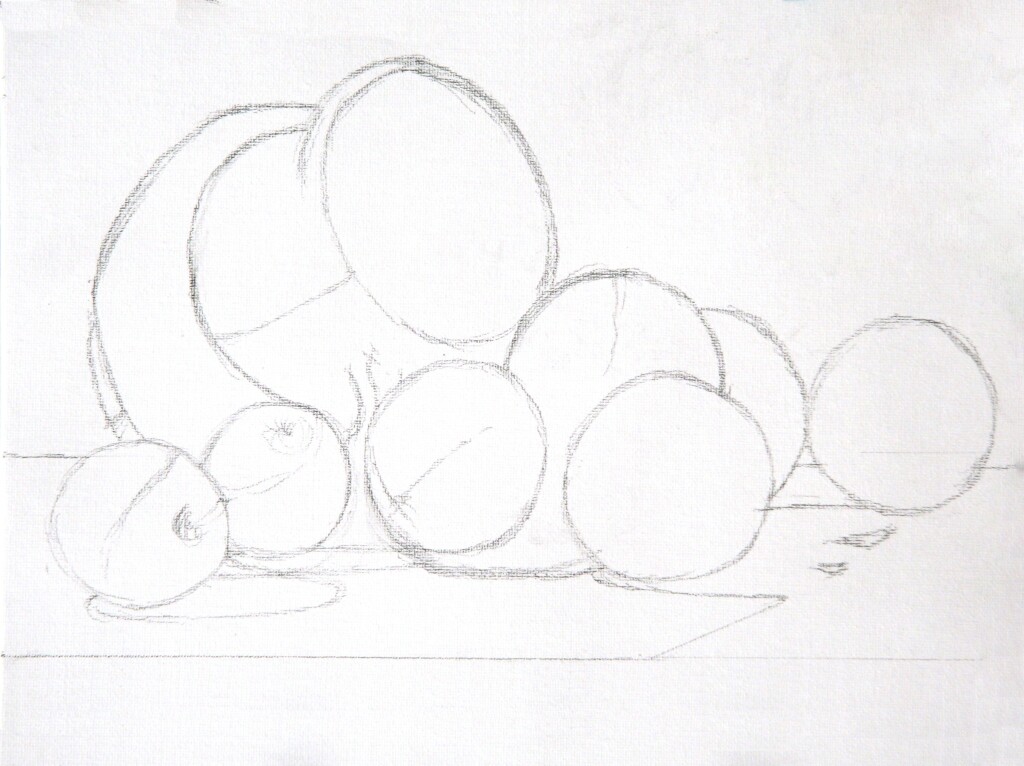
Time to explore
With a 4B graphite pencil, I draw the scene. I scrub the under-painting on with a bristle brush, therefore the drawing needs to stay in place and not smudge. So the drawing in held in place by spraying it with workable fixative.
Freehand only – no tracing
Although I often use photographs for reference, I always draw my subject freehand and never trace. I find the results of tracing to be lifeless and it doesn’t challenge me enough to understand my subject. In contrast, freehand drawing encourages me to explore, alter the composition, and get much better understanding of all its elements and their relationship to each other. I get a feel of the rhythm of both the placement of elements and their orientation – the directions they lean and how that rhythm creates interesting movement.
STEP 3: Blocking in
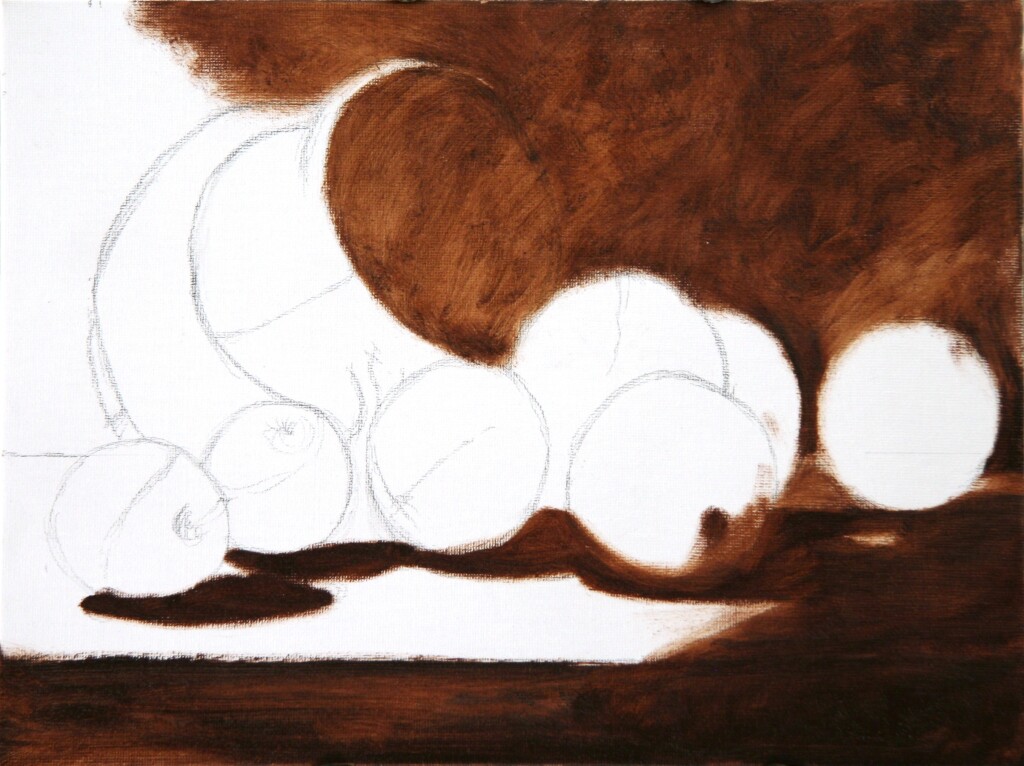
Focus on the large dark shapes
Burnt umber, cooled with a touch of viridian, is scrubbed on to the canvas with hog hair bristle brushes, continuing the “drawing” stage by adding form and shadow. I also indicate the darkest dark areas. However, until the final stages of a painting, I avoid painting the extreme dark and light values.
STEP 4: Block-in
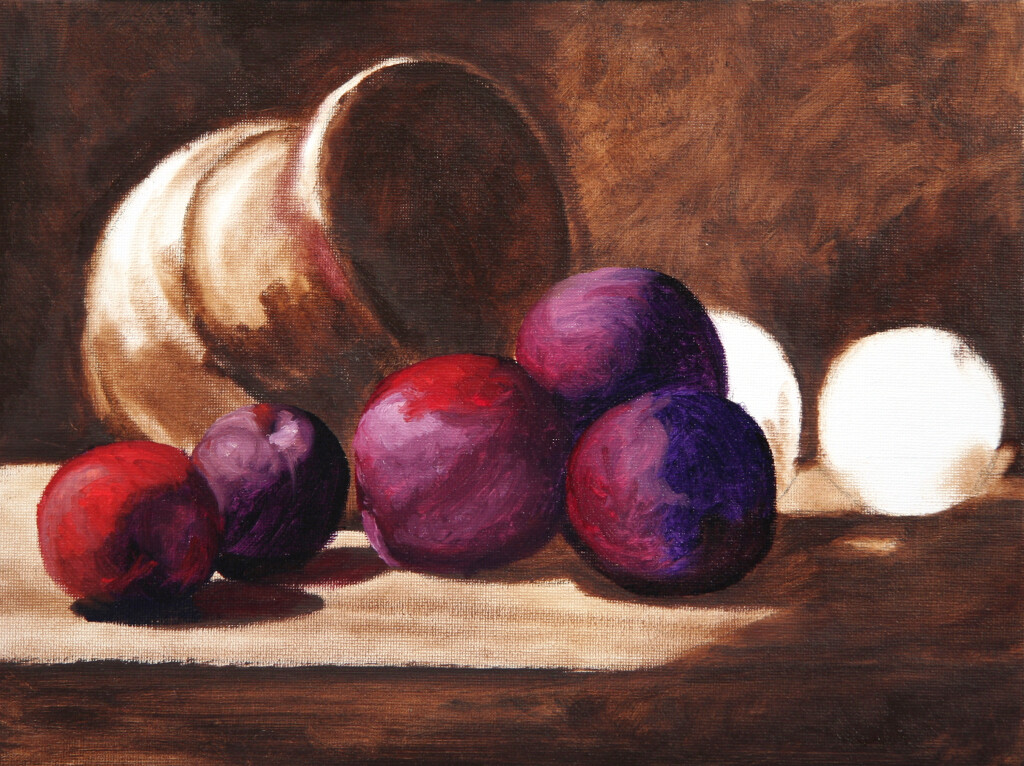
Transparent colors for depth
Dark areas – background and shadows – have been defined. The plum shapes are left white. The painting’s focus is the spectacular colors of the plums. I paint the fruit primarily with mixtures or transparent paints – anthraquinone red, alizarin crimson, ultramarine blue. The transparent nature of these colors is critical for those colors to retain the depth and saturation I desire in the shadows and darker skin of the plums. Therefore, I don’t want the underpainting’s burnt umber to effect it. The blocking in continues…
STEP 5: Block-in complete
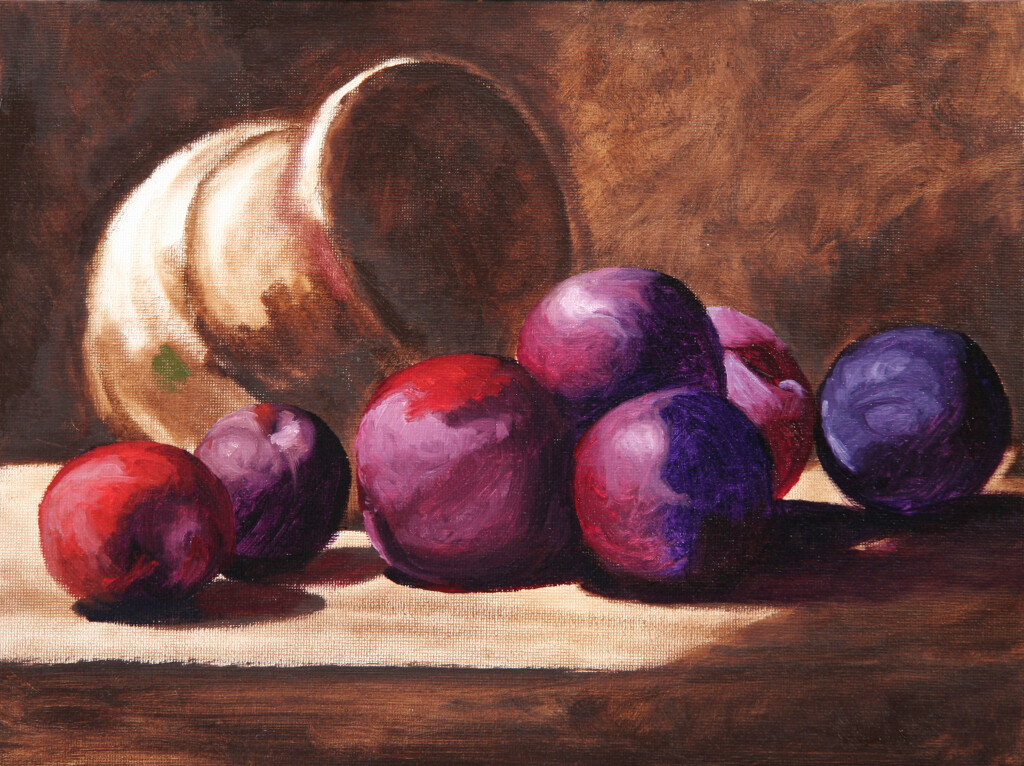
Block-in finished, now what?
All elements are now in place. The darkest spaces are established, the lightest areas of the vase and table are indicated, and there is a hint of where highlights will be painted later.
Plums start to take shape
I begin working on the waxy areas of the skin with mixtures of anthraquinone red and ultramarine blue with white creating soft pinks, lavenders, and blues. In addition to lightening the color, adding white colors reduces the vibrancy and cools the color. The result of the mix is perfect for the effect of diffused reflected light and again, help intensify the brilliance of the stronger warm red and oranges and the richness of the cool highly saturated blues and purples.
The light emitted from a translucent material, like the plum’s skin, is far more vibrant than reflected light. Think stained glass windows. To create that effect, I use hot, cadmium red on the plums where the light is traveling through the plum’s skins. Ultimately these colors the edges of these colors will be lightly blended.
STEP 6: Close to the Finish

Plums get their color
Because this painting is about the amazing colors of the plums (purple, red, orange), I want to enhance them by adding a contrasting color (green to yellow-green). These colors are at opposites sides on the color wheel. As a result, the combination creates a nice bit of interest and balance.
The Green Vase
The vase’s base green color is a mixture of ivory black and Indian yellow, making a lovely olive green. Lightness and darkness of the green is modulate the with white. To preserve the rugged feeling of the vase and to complement the highly saturated plum colors the greens are muted with transparent red iron oxide.
STEP 7: Finish – my favorite part

Details
Refining edges and shadows; adding subtle reflected light; and adding highlights, is always my favorite stage.
Edges and shadows
Hard edges separate shapes while soft edges connect them. To anchor the plums to the table and unite them with each other I soften the edges concentrating on the central group – opening of the vase and cast shadows on the tabletop.
Mixtures of ultramarine blue and alizarin crimson gives a cool, rich, and deep transparent background. The shadow cast onto the table, burnt umber added to the background color, falls subtly over the front edge of the table.
Reflected light
I love reflected light. You can see it most clearly in the reflection from the table in center plum and the plum to the right of it. Reflected light helps give the illusion of roundness to the plums.
Highlights
I use Spectral (hard) and diffused (soft) highlights in Plums. .
Spectral highlights have hard, sharp edges making a surface appear hard, and reflective. I used spectral highlights exclusively in edges of the vase, contrasting the rough surface of the vase with the smooth skins of the plums.
Diffused highlights have soft edges. Depending on how hard or soft the edge is determine how hard, smooth or textured the surface will appear. Although plums are smooth-skinned fruit, their skins reflect a soft-edged light in the same way a balloon might.
Finished?
At some point, I have to say it is done. I am never sure when that time has come. Most likely, I will return to Plums a week or so and see if it wants a little more work.
GREAT RESOURCES
These books have a treasured place in my studio.
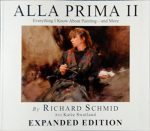 Alla Prima II Everything I Know about Painting and More
Alla Prima II Everything I Know about Painting and More by Richard Schmid
Alla Prima, this book offers to the artist and art lover alike the wisdom and technical savvy which comes from a classical education and a lifetime of painting and teaching. Writing as an acknowledged master, Richard gracefully leads his reader through the subtleties of painting theory and technique with refreshing directness and unmatched technical authority. With an emphasis on painting from life, he writes with warm humor about the joys and trials of being an artist. He brings to life the romance of Bravura painting and examines the mysteries of color in fascinating detail.
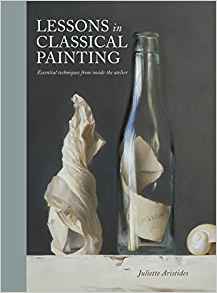 Lessons in Classical Painting: Essential Techniques from Inside the Atelier
Lessons in Classical Painting: Essential Techniques from Inside the Atelier by Juliette Aristides
Lessons in Classical Painting presents aspiring artists with the fundamental skills and tools needed to master painting in the atelier style. With more than 25 years of experience in ateliers and as an art instructor, Aristides pairs personal examples and insights with theory, assignments and demonstrations for readers, discussions of technical issues, and inspirational quotes.
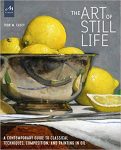 The Art of Still Life
The Art of Still Life by Todd M. Casey
The Art of Still Life offers a comprehensive, contemporary approach to the subject that instructs artists on the foundation basics and advanced techniques they need for successful drawing and painting. In addition to Casey’s stunning paintings, the work of over fifty past and present masters is included, so that the book is both a hardworking how-to manual and a visual treasure trove of some of the finest still life art throughout history and today.
 The Art Spirit by Robert Henri
The Art Spirit by Robert Henri
“Art when really understood is the province of every human being.” So begins The Art Spirit, the collected words, teachings, and wisdom of innovative artist and beloved teacher Robert Henri. Henri, who painted in the Realist style and was a founding member of the Ashcan School, was known for his belief in interactive nature of creativity and inspiration, and the enduring power of art.
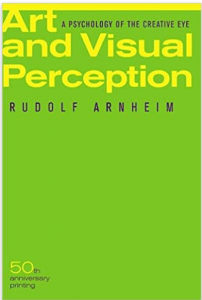 Art and Visual Perception
Art and Visual Perception by Rudolf Arnhiem
Since its publication fifty years ago, this work has established itself as a classic. It casts the visual process in psychological terms and describes the creative way one’s eye organizes visual material according to specific psychological premises. In 1974 this book was revised and expanded, and since then it has continued to burnish Rudolf Arnheim’s reputation as a groundbreaking theoretician in the fields of art and psychology.

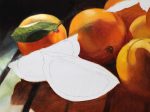
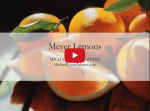

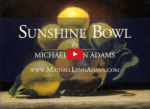
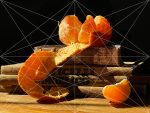
What brand of Anthracqudone Red due you prefer?
Your paintings are amazing!
I use M Graham oil paints pretty much exclusively.